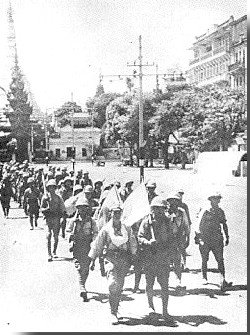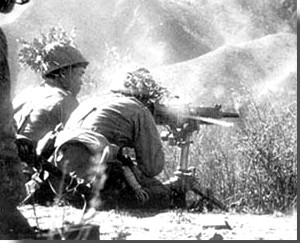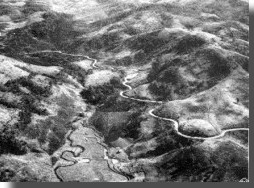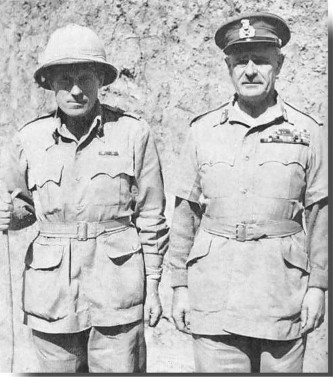MAPS & TERMS
A N e w E n e m y
S e t t i n g
S e t t i n g
S e t t i n g
Background
photo caption
Victorious Japanese
troops marching into Rangoon. Eventually 4 divisions were all that was needed to defeat a mixed British-Chinese force of 8 divisions. British & Commonwealth casualties alone outnumbered Japanese ones by a ratio of 5 to 1.3
Photograph courtesy of
the Imperial War
Museum, London


The spring of 1942 saw a continuation of the string of Allied defeats inflicted by the Japanese since December, 1941. Allied military power was being shattered in the Pacific and Asia as the Japanese initiated military conquests and raids in their quest for empire. In its efficiency and speed Japanese military prowess was shocking its opponents and inflicting defeats by land, sea and air. The British colonies of Hong Kong, Malaya and the important base at Singapore had fallen. American & Australian forces were suffering defeats in the Philippines and across the Pacific, their naval and air power badly damaged. These victories were designed to reduce any vulnerability to the use of the main prize of the Dutch East Indies and British Borneo with their rich economic resources.
The Japanese advance into Burma was part of this strategy. Specifically the invasion of Burma was to secure the flank for the conquest of Malaya. And it was also designed to cut the only Allied ground supply link to Nationalist China that ran through Burmese territory into China. Once this all-weather supply route known as the Burma Road was cut, it was believed Chinese resistance would weaken. Beginning in January of 1942, throughout that spring the Japanese began to soundly inflict defeats upon a numerically superior force of British and American-led Chinese.
The Allies were beaten by a more aggressive and tactically proficient army. The Japanese military skill was underestimated, their battlefield courage, speed, and stamina coming as a surprise. The British were hobbled by a lack of sufficient training and equipment, and the Chinese forces provided to be ineptly and often criminally led. Most of the lowland Burmese (the majority in the nation of 17 million) welcomed the defeat of the British colonialists. They deserted from British-led army units, and some actively co-operated with Japanese forces. The exception was the minority population in the north and east, the hill tribes of the Karen, Shan, Kachin, and Naga (which would remain mostly loyal to the Allies during the war). Rangoon was abandoned in March, and by the end of May Burma had fallen to the Japanese.
photo caption
Japanese forces in action. During the 1942 fighting the British were handicapped by an incoherent strategy, while the Chinese often refused to obey General Stilwell's orders. Wavell who commanded the war front wrote he under-
estimated the Japanese ability & strategy.
Photograph courtesy of
the Imperial War
Museum, London

 The British suffered the longest retreat in their military history. The demoralized Allied forces followed by masses of refugees were pushed back nearly a thousand miles to the gates of India. British forces fell back into eastern India while some Chinese forces under American General Stilwell headed to the north-east corner of India. The Japanese stopped upon reaching the Indian border not because of Allied resistance, but because of the harsh terrain and the thinness of their forces. Their original goal of establishing a buffer was accomplished. While the Japanese settled down to become the occupier, the Allies took stock. Burma was a remote outpost, yet this country did have a strategic value not just to the Japanese.
The British suffered the longest retreat in their military history. The demoralized Allied forces followed by masses of refugees were pushed back nearly a thousand miles to the gates of India. British forces fell back into eastern India while some Chinese forces under American General Stilwell headed to the north-east corner of India. The Japanese stopped upon reaching the Indian border not because of Allied resistance, but because of the harsh terrain and the thinness of their forces. Their original goal of establishing a buffer was accomplished. While the Japanese settled down to become the occupier, the Allies took stock. Burma was a remote outpost, yet this country did have a strategic value not just to the Japanese.
The Prize
Burma beckoned with reasons to the Allies to return, ensuring it would remain a battleground. To the British, Burma was a Japanese base to threaten India with either a military invasion or to ferment internal dissent. Re-taking it meant ending the threat to India. And there was another important reason. To overcome the sense of disgrace at being soundly defeated and kicked out of her Asian colonies, and to ally concerns over holding together the British Empire in the future, Burma demanded to be re-conquered. Casting their eyes on their priced lost jewel of Singapore, Burma in British hands meant a springboard for the re-conquest of her lost Asian colonies. Some high officials and commanders believed it was through conquest of southern Burma with amphibious assaults that this could occur (which is why in the fall of 1943, an Admiral, Lord Mountbatten, was appointed theater commander), and not through the northern jungles with its inadequate logistical network. British commanders were also under pressure from the Americans and Prime Minister Churchill for positive results. Always pushing for offensive action from his field commanders, knowing Britain was dependent upon American aid fueled Churchill's desire to demonstrate that Britain should and would not be eclipsed in the war effort.
photo caption
The Burma Road. The supply line ran from the harbor of Rangoon, up the railway line to Mandalay, then by road to the Chinese city of Chungking. After the fall of Burma, a route was set up to fly supplies over the Himalayas called, "The Hump."
Photograph courtesy of
the Imperial War
Museum, London
 To the Americans, the re-conquest of Burma meant the crucial easing of supply difficulties to China. Keeping China and the several million Nationalist troops of Chaing Kai-Shek (the leader of Nationalist China) in the war to fight and tie down the bulk of the Japanese army was a top American priority. Keeping the Nationalists fighting also meant ensuring access to Chinese air bases to raid Japan. President Roosevelt's government feared a collapse of Chinese resistance and thus a bloody prolongation of the war, and a fear over future Asian stability. And there was also much popular sympathy in the U.S. to help China in its fight. So a steady supply of American arms, equipment, and money to China was needed. Previously the Burma Road served as the supply conduit into southern China. Losing Burma forced the Americans to expend enormous resources to transport a fraction of the previous amount of supplies from Indian bases some 500 miles by air over the dangerous Himalayan Mountains. Re-taking northern Burma would allow the building of an overland supply road to China, via India into northern Burma to link up with the old Burma Road and thence into China.
To the Americans, the re-conquest of Burma meant the crucial easing of supply difficulties to China. Keeping China and the several million Nationalist troops of Chaing Kai-Shek (the leader of Nationalist China) in the war to fight and tie down the bulk of the Japanese army was a top American priority. Keeping the Nationalists fighting also meant ensuring access to Chinese air bases to raid Japan. President Roosevelt's government feared a collapse of Chinese resistance and thus a bloody prolongation of the war, and a fear over future Asian stability. And there was also much popular sympathy in the U.S. to help China in its fight. So a steady supply of American arms, equipment, and money to China was needed. Previously the Burma Road served as the supply conduit into southern China. Losing Burma forced the Americans to expend enormous resources to transport a fraction of the previous amount of supplies from Indian bases some 500 miles by air over the dangerous Himalayan Mountains. Re-taking northern Burma would allow the building of an overland supply road to China, via India into northern Burma to link up with the old Burma Road and thence into China.
To the Nationalist Chinese government the re-conquest of Burma meant a strengthening of its rule. The Nationalist regime under Chaing Kai-Shek was more interested in consolidating its power and building up its forces than in fighting the Japanese and risking loyal troops and equipment. Its focus was on preserving strength for future battles in the long-running Chinese Civil War against the growing Communist forces. Demonstrating token action against the Japanese meant the ability to maintain the flow of foreign supplies, complemented by bluffing to threaten to withdraw from the war. The Americans were trying with much frustration to get the Nationalist forces to reform and respond to American military advisors and ideas. To Chaing Kai-Shek, American reforms and control over military operations meant a weakening of loyalty to his regime and the growth of potential threats to him. Together, all this translated into Chinese inertia, corruption and opposition to fighting.
photo caption
Wingate with Wavell. Before Wavell's appoint-
ment as theater chief in December of 1941, SOE created a guerilla warfare and sabotage school in Burma to train Allied personal to assist the Chinese.
Photograph courtesy of
Her Majesty's Stationary
Office, London
It was these concerns and conflicting desires which were to mold Allied strategy and shape Wingate's missions. Considering their goals the Allies in the India-Burma Theater in 1942 and into 1943 were short of many things. This included troops, equipment, and a sufficient logistic base. The theater ranked at the bottom of supply priorities, made more difficult by the long supply line (2 months by sea from the U.S. to India). After their defeat the British needed time rebuilding & re-equipping the Allied forces in India as well as building up logistics and communications. There was civil unrest in India diverting troops. The Indian Army, with many of its best units fighting in the Middle East or already captured in Singapore, needed to undergo rebuilding. Just as importantly, morale and confidence of the British and Indian forces needed to be completely rebuilt. Disappointed at the string of defeats, Winston Churchill wrote, "going into swampy jungles to fight Japanese is like going into the water to fight a shark."2 The British Indian military command was in shock from the scale of the defeat & was slipping into a passive, defensive mentality.
 Wingate
reported for duty
at New Delhi, India on March 19th, during the rout from Burma. Promoted to full colonel, he answered to General Archibald Wavell, his old commander from Palestine and the Middle East. Wavell was now the Commander-in-Chief India, the Allied commander responsible for the Indian front, including Burma. The general ordered Wingate to take charge of guerilla warfare operations against the advancing Japanese. Wingate set about learning as much as he could amidst the ongoing defeat about the Japanese and Burma.
Wingate
reported for duty
at New Delhi, India on March 19th, during the rout from Burma. Promoted to full colonel, he answered to General Archibald Wavell, his old commander from Palestine and the Middle East. Wavell was now the Commander-in-Chief India, the Allied commander responsible for the Indian front, including Burma. The general ordered Wingate to take charge of guerilla warfare operations against the advancing Japanese. Wingate set about learning as much as he could amidst the ongoing defeat about the Japanese and Burma.
1. Louis Allen, Burma, The Longest War
(New York: St. Martin's Press, 1984), 120.
2. Winston Churchill, The Second World War, Vol.IV: The Hinge of Fate (Boston: Houghton Mifflin, 1951), 683.
3. Allen, 683.

